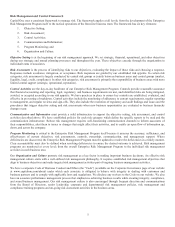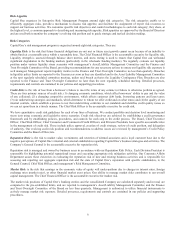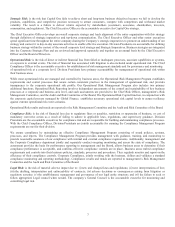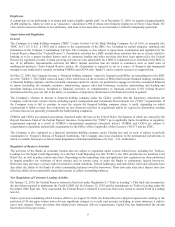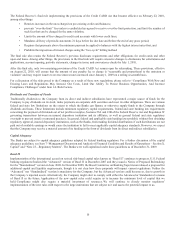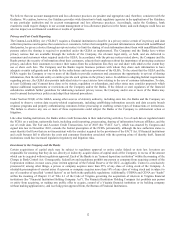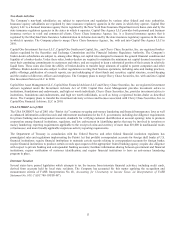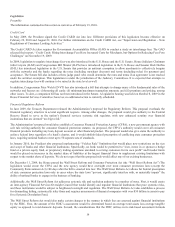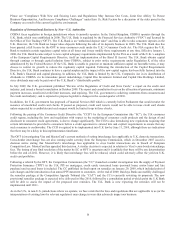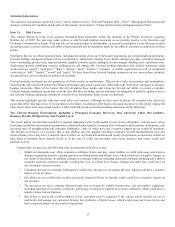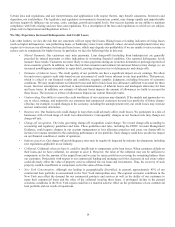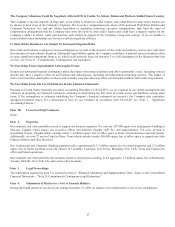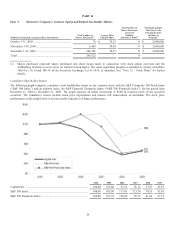Capital One 2009 Annual Report Download - page 28
Download and view the complete annual report
Please find page 28 of the 2009 Capital One annual report below. You can navigate through the pages in the report by either clicking on the pages listed below, or by using the keyword search tool below to find specific information within the annual report. 15
would be modified to include the risks to the deposit insurance fund posed by the uninsured affiliates of the depository institution.
Third, the FDIC would be required to consider off-balance sheet exposures when setting its rates. The FDIC’s current authority to
establish separate assessment systems for large and small institutions would be eliminated. Furthermore, regulatory agencies would be
required to adopt joint regulations requiring creditors and securitizers to retain at least five percent of the credit risk with respect to
such credit or security and prohibit the hedge or transfer of such risk. The agencies could reduce or increase the five percent
requirement depending on the circumstances.
The Wall Street Reform Act also addresses shareholder measures, including requiring public companies to provide shareholders with a
non-binding vote with respect to executive compensation and to have a compensation committee comprised solely of independent
directors. Additionally, the federal banking regulators, the Securities and Exchange Commission (SEC), and the Federal Housing
Finance Agency (FHFA) would be required to jointly issue regulations prohibiting any compensation package that encourages
executives to take risks that could seriously affect the economy or threaten a financial institution’s safety and soundness. The act also
includes substantial portions of H.R. 1728, the Mortgage Reform and Anti-Predatory Lending Act, which the House passed in May
2009 (and discussed below in “Housing and Mortgage Lending”).
No companion bill to the Wall Street Reform Act has yet been introduced in the Senate.
Proposed TARP Assessment
In January 2010, the President announced additional proposals that would impact financial institutions. The first proposal would levy a
new tax on institutions within the financial sector to recoup the benefits certain institutions have received under government assistance
programs, including TARP. The annual fee would be assessed at a rate of 15 basis points of “covered liabilities” for financial firms
with more than $50 billion in consolidated assets (excluding Tier 1 capital, FDIC-assessed deposits and insurance policy reserves). To
date, Congress has not put forth legislation on this issue. If the proposal is enacted as described above, the impact to the Company is
estimated to be $154 million.
Housing and Mortgage Lending
Since 2008, Congress has also focused on the housing market, looking at both retrospective and prospective solutions. In July 2008,
legislation was enacted to create additional federal backstops and strengthen regulation of the Government Sponsored Enterprises
(“GSEs”), including an overhaul of the Federal Housing Administration (“FHA”) programs. In May 2009, H.R. 1728, the “Mortgage
Reform and Anti-Predatory Lending Act” was passed in the House. The legislation would place a federal duty of care on mortgage
originators, lower the threshold for loans covered under the Home Ownership and Equity Protection Act (HOEPA), as well as address
assignee liability and require that securitizers retain access to all loans packaged and sold. As discussed above, in December 2009, this
legislation was included in the Wall Street Reform Act that passed the U.S. House.
In May 2009, the President signed the “Helping Families Save Their Homes Act” which provides various types of foreclosure relief
and changes to the mortgage marketplace. Among other things, the law would require the OCC, OTS and HUD to report to Congress
on the number and type of loan modifications made by entities under their supervision; provide a limited safe harbor for any mortgage
loan servicer that enters into a “qualified loss mitigation plan” with a borrower whose loan is held in a securitization vehicle; make
various changes to the HOPE for Homeowners Act of 2008 (H4H) by providing greater incentives for mortgage servicers to engage in
modifications and reducing administrative burdens on loan underwriters; require new owners of mortgage loans to give notice to
borrowers of the sale, transfer or assignment of the loan within 30 days of such sale, transfer or assignment and to provide certain
information; and require 90 days notice to terminate the lease of a bona fide tenant of a foreclosed-upon dwelling.
Bankruptcy
There have been several proposals in Congress to modify the bankruptcy laws to permit homeowners at risk of foreclosure to receive a
modification of their primary mortgages. On October 20, 2008, President Bush signed the “National Guard and Reservists Debt Relief
Act of 2008,” making bankruptcy filings easier for national guardsmen and reservists.
Broad bankruptcy legislation that could be seen as creating incentives for consumers to choose Chapter 13 bankruptcy as a primary
remedy for mortgage related problems was also introduced in 2009. This legislation passed the U.S. House in March 2009; however,
when it was offered as an amendment to a separate bill in the U.S. Senate, it was defeated. The Senate sponsor, Senator Dick Durbin,
has stated he intends to continue working to enact the legislation and will use other available legislative vehicles, including
reintroducing the amendment at a later date. During the House consideration of the comprehensive regulatory reform bill in December
2009, the bankruptcy amendment was offered, but failed. Finally, Senators Whitehouse (D-RI) and Durbin have introduced legislation
to disallow claims arising from “high cost consumer credit” in bankruptcy proceedings. The Senate Judiciary Committee has yet to
take action on the bill; however, the bill was placed on the Committee calendar for consideration but has not been brought up for
debate and vote.


